Washington DC, the capital of the United States, is not only famous for its magnificent historical architecture but also a paradise for photography enthusiasts. From the majestic White House and the magnificent Capitol Building to the emotionally resonant Lincoln Memorial, every landmark in Washington DC exudes a unique beauty, inspiring endless creativity for photographers. If you are passionate about photography and want to explore Washington DC in a special way, an artistic photography tour is the perfect choice for you.
This article will take you on a photographic journey to discover Washington DC’s most famous destinations, suggesting unique framing ideas and sharing tips to help you create impressive artistic works during your trip.
1. The White House: Symbol of American Power Through the Lens
The White House, a symbol of American power, is a must-visit destination on any artistic photography tour in Washington DC. More than just the residence and workplace of the US President, the White House is an architectural masterpiece steeped in history and culture, attracting millions of tourists and photographers worldwide.
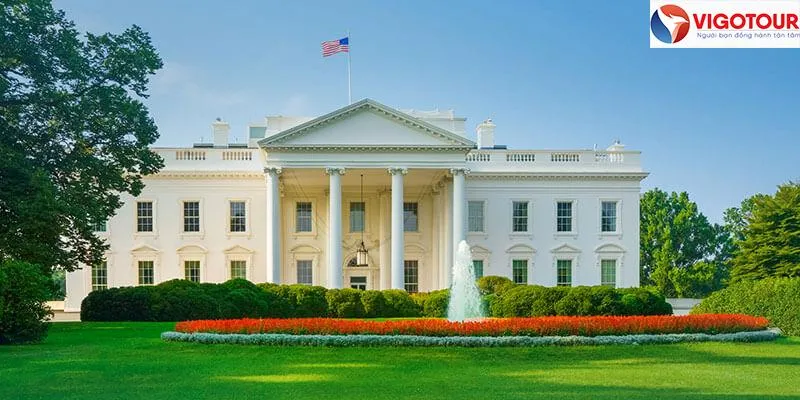
Ideal Angles and Times:
- Early Morning or Late Afternoon: The soft light of dawn or dusk will create warm colors, highlighting the classic and majestic beauty of the White House. Find a shooting angle from Lafayette Park for a wide and comprehensive frame.
- Frontal Angle: Stand opposite the White House and shoot directly to capture the perfect symmetry of its architecture. Use a wide-angle lens to encompass the entire building in the frame.
- Close-up Angle: Focus on unique architectural details such as columns, windows, or arches to create abstract and artistic photos.
- Reflection Shots: If possible, find puddles or reflective surfaces to create unique symmetrical images, adding depth and creativity to your work.
- Black and White Photography: To honor the historical beauty and classic architecture of the White House, try switching to black and white mode. The contrast between light and shadow will highlight the lines and volumes of the building.
Artistic Photography Tips:
- Use ND Filters: If shooting during the day, an ND filter will help reduce the amount of light entering the lens, allowing you to use a wider aperture to blur the background and emphasize the White House as the subject.
- Experiment with Slow Shutter Speeds: In the evening, you can experiment with slow shutter speeds to capture light trails from moving vehicles, creating unique lighting effects around the White House.
- Take Portrait Photos with the White House as a Backdrop: If you are traveling with friends or family, don’t forget to take portrait photos with the White House as a backdrop. These will be memorable souvenirs of your artistic photography tour.

2. The Capitol Building: Magnificent Dome Architecture Through a Photographer’s Lens
The Capitol Building, also known as the US Capitol, is another architectural symbol of Washington DC, famous for its massive dome and intricate design. On an artistic photography tour, the Capitol Building offers countless opportunities to showcase your creativity and photographic skills.
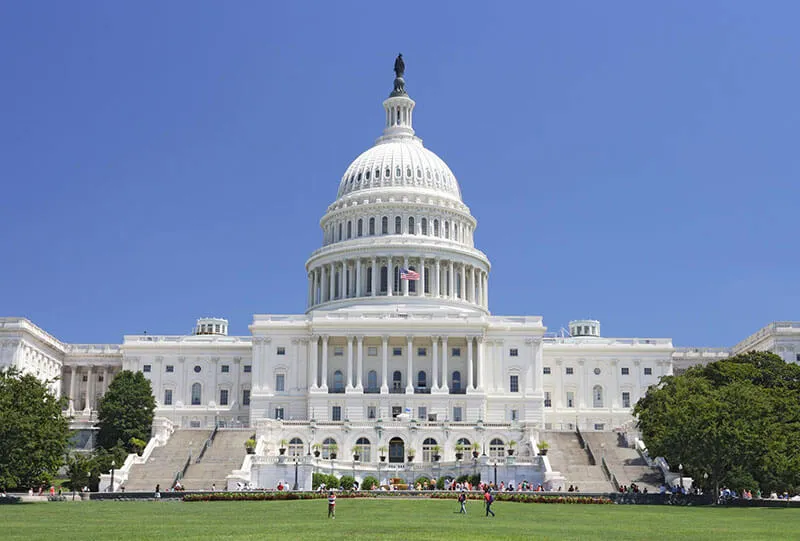
Ideal Angles and Times:
- Panoramic Angle from Afar: To admire the overall beauty of the Capitol Building, find locations with open views such as the National Mall or surrounding parks. Use a telephoto lens to narrow the distance and highlight the magnificent dome.
- Close-up Dome Angle: Get closer to the Capitol Building and focus on the dome to capture close-up shots of its intricate architectural details. Pay attention to the symmetry and unique decorative patterns.
- Angle from Inside: If you have the opportunity to visit inside the Capitol Building, don’t miss the chance to photograph the dome from within. Natural light streaming through the windows will create beautiful lighting effects.
- Shoot During Golden Hour: The warm light of the golden hour will highlight the colors and textures of the white marble, creating shimmering and magical photos.
- Night Photography: The Capitol Building is brightly lit at night, creating a magnificent and splendid scene. Use a tripod and long exposure to capture this magical beauty.
Artistic Photography Tips:
- Use HDR (High Dynamic Range) Technique: To capture details in both bright and dark areas in high contrast lighting conditions, use HDR technique. This technique allows you to create photos with a wide dynamic range, fully showing details of both the sky and the architecture.
- Find Leading Lines: Use roads, rows of trees, or other architectural elements to create leading lines that guide the viewer’s eye to the Capitol Building. Leading lines will help create depth and increase the appeal of the photo.
- Shoot Panorama Photos: To encompass the entire Capitol Building and surrounding landscape, shoot panorama photos. This technique allows you to create photos with an ultra-wide angle of view, capturing the entire majestic scene.
- Creative Portrait Photography: Take advantage of the unique architecture of the Capitol Building to create creative portrait photos. Experiment with different shooting angles and use natural light to highlight the subject.
3. Abraham Lincoln Memorial: Discovering Eternal Beauty Through Artistic Photos
The Lincoln Memorial is not only a monument commemorating the great US President but also an emotionally resonant architectural artwork. On an artistic photography tour, this is an ideal place to express historical respect and discover eternal beauty through the lens of photography.
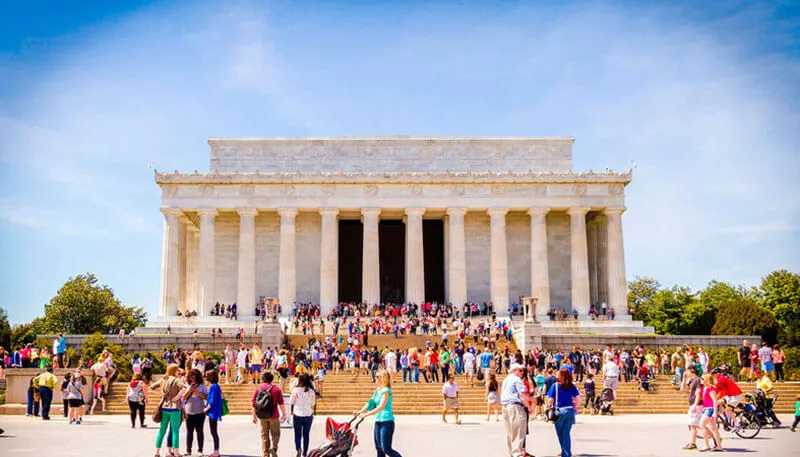
Ideal Angles and Times:
- Frontal Angle of the Lincoln Statue: Stand directly in front of the Lincoln statue and shoot a full view of the monument. Use a wide-angle lens to capture both the statue and the surrounding space.
- Close-up Angle of the Lincoln Statue: Get closer and take close-up shots of Lincoln’s face and majestic demeanor. Pay attention to the eyes and expression on the statue’s face.
- Angle from the Steps: Climb the steps and shoot downwards to get a view from above looking down at the Lincoln statue and the space in front. This shooting angle will create depth and grandeur for the photo.
- Reflection Shots in the Reflecting Pool: The Reflecting Pool in front of the Lincoln Memorial is an ideal location for reflection shots. Find a shooting angle to get the perfect symmetrical image of the monument and the pool.
- Night Photography: The Lincoln Memorial is beautifully lit at night, creating a solemn and magical scene. Use a tripod and long exposure to capture this beauty.
Artistic Photography Tips:
- Use Natural Light: Natural light is an important element in creating beautiful photos at the Lincoln Memorial. Take advantage of sunlight in the early morning or late afternoon to get soft and warm light.
- Focus on Details: In addition to the Lincoln statue, pay attention to other architectural details of the monument such as marble columns, bas-reliefs, and inscriptions on the walls. These details will help you tell the historical and cultural story of the monument.
- Black and White Photography: To honor the classic and solemn beauty of the Lincoln Memorial, try black and white photography. The contrast between light and shadow will highlight the lines and volumes of the monument.
- Expressive Portrait Photography: Take advantage of the solemn and historical space of the Lincoln Memorial to create expressive portrait photos. Combine light, shooting angles, and the model’s expression to convey messages and emotions.
4. Vietnam Veterans Memorial: Capturing Historical Imprints Through the Lens
The Vietnam Veterans Memorial is a special memorial, imbued with humanity and history. The V-shaped black granite wall engraved with the names of thousands of American soldiers who died in the Vietnam War is a moving highlight of any artistic photography tour in Washington DC.

Ideal Angles and Times:
- Panoramic Angle of the Wall: Shoot a panoramic view of the V-shaped black granite wall to show the vastness and solemnity of the memorial. Use a wide-angle lens to encompass the entire wall in the frame.
- Close-up Angle of Soldiers’ Names: Get closer and take close-up shots of the lines of soldiers’ names engraved on the wall. This shooting angle will create emotion and respect for those who sacrificed themselves.
- Reflection Shots: The glossy black granite surface of the wall creates excellent reflection possibilities. Find a shooting angle to capture reflections of the surrounding scenery or yourself on the wall.
- Shoot in Late Afternoon: The oblique light of the late afternoon will create long shadows on the wall, highlighting the names and creating unique lighting effects.
- Black and White Photography: To enhance the solemnity and emotion of the photo, try black and white photography. The contrast between light and shadow will highlight the details and volumes of the wall.
Artistic Photography Tips:
- Express Emotions: The Vietnam Veterans Memorial is a place filled with emotion. Try to convey these emotions in your photos. Use visual language to tell a story of sacrifice, loss, and peace.
- Pay Attention to Light and Shadows: Light and shadows play an important role in creating atmosphere and emotion for the photo. Observe how light changes during the day and take advantage of them to create impressive photos.
- Find Human Elements: If possible, take photos with the presence of people at the memorial. Images of visitors, placing flowers, or quietly commemorating will add humanity and meaning to the photo.
- Use Minimalism Technique: To focus on the solemnity and emotion of the memorial, use minimalism technique. Eliminate extraneous elements and focus on important details such as the black granite wall and the lines of soldiers’ names.
5. Jefferson Memorial: Classic Beauty and Stunning Panoramic Angles
The Jefferson Memorial, resembling the Parthenon in Rome, is a beautiful classical architectural work, honoring the third US President. On an artistic photography tour, the Jefferson Memorial is not only a sightseeing destination but also an endless source of inspiration for photographers.
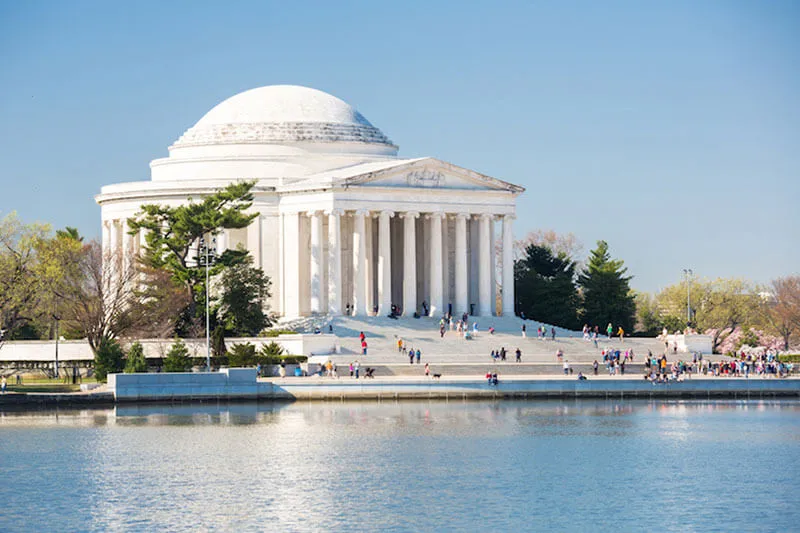
Ideal Angles and Times:
- Frontal Angle from Afar: Shoot a full view of the Jefferson Memorial from a distance, especially from the Tidal Basin side. This shooting angle will show the majestic beauty and perfect symmetry of the building.
- Close-up Angle of Columns: Get closer and take close-up shots of the white marble columns. Pay attention to the architectural details and decorative patterns on the columns.
- Angle from Inside the Dome: If you have the opportunity to visit inside, don’t miss the chance to take photos from inside the dome. Natural light streaming in will create unique lighting and shadow effects.
- Shoot at Sunrise or Sunset: The soft light of sunrise or sunset will highlight the colors and textures of the white marble, creating romantic and magical photos.
- Panoramic Photos with the Tidal Basin: Combine the Jefferson Memorial with the Tidal Basin in a panoramic frame. The pool will add depth and poetry to the photo.
Artistic Photography Tips:
- Use the Rule of Thirds: Apply the rule of thirds to compose the photo. Place the Jefferson Memorial in one-third of the frame to create balance and harmony.
- Find Leading Lines: Use roads, rows of trees, or the lake shore to create leading lines that guide the viewer’s eye to the Jefferson Memorial. Leading lines will help increase the appeal and depth of the photo.
- Portrait Photography with the Jefferson Memorial as a Backdrop: Take advantage of the classical and majestic beauty of the Jefferson Memorial to create impressive portrait photos.
- Experiment with Tilt-Shift Lenses: If you want to create special effects such as miniaturizing space or selective blurring, experiment with Tilt-Shift lenses. This lens will help you control the depth of field and create unique photos.
6. Tidal Basin: Photography Paradise for Cherry Blossoms and Reflective Landscapes
The Tidal Basin, located just south of the National Mall, is one of the most photographed locations in Washington DC. Especially in spring, when cherry blossoms bloom, the Tidal Basin becomes a photography paradise with stunning scenery and endless photo opportunities on an artistic photography tour.
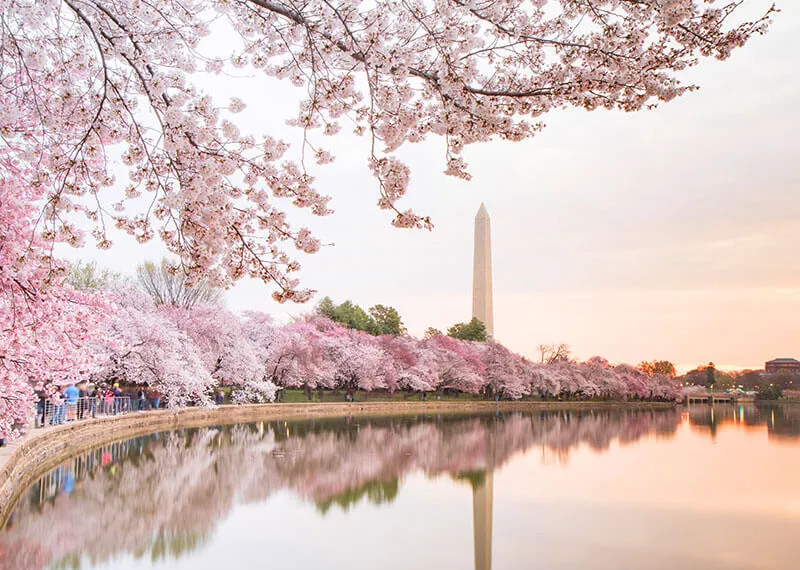
Ideal Angles and Times:
- Cherry Blossom Photography: Cherry blossom season (usually in late March, early April) is a great opportunity to photograph cherry blossoms at the Tidal Basin. Find the best shooting angles to capture the brilliant beauty of the cherry blossoms.
- Reflection Shots: The still water surface of the Tidal Basin creates excellent reflection possibilities. Take advantage of this to photograph reflections of surrounding architectural works such as the Jefferson Memorial, Washington Monument, and Martin Luther King Jr. Memorial.
- Shoot at Sunrise or Sunset: The golden light of sunrise or sunset will make the Tidal Basin scenery more shimmering and magical. This is an ideal time for landscape and portrait photography.
- Panoramic Photos: Find high vantage points to shoot panoramic photos of the Tidal Basin and the surrounding area. This shooting angle will show the vastness and overall beauty of the location.
- Cherry Blossom Macro Photography: In addition to landscape photos, don’t forget to take macro close-up photos of cherry blossoms. This shooting angle will help you discover the delicate beauty and details of each flower.
Artistic Photography Tips:
- Be Patient and Wait: Cherry blossom season attracts many tourists and photographers. Be patient and wait to get the best and uncrowded frames.
- Use Telephoto Lenses: Telephoto lenses will help you compress perspective and highlight cherry blossoms. You can also use telephoto lenses to take portrait photos with cherry blossoms as a backdrop.
- Pay Attention to the Background: The background plays an important role in cherry blossom photos. Choose a simple and uncluttered background to highlight the subject, which is the cherry blossoms.
- Experiment with Different Shooting Angles: Don’t be afraid to experiment with different shooting angles to find the most unique and creative frames. Get low, climb high, or move around to explore new perspectives.
- Photograph in Different Weather Conditions: Weather can change quickly in Washington DC. Take advantage of different weather conditions such as sunny, cloudy, or rainy days to create diverse and rich photos.
7. National Air and Space Museum: Exploring Infinite Space Through Artistic Photos
The National Air and Space Museum is an attractive destination for science and technology enthusiasts. On an artistic photography tour, this museum offers a unique opportunity to explore infinite space and capture historical artifacts through the lens of photography.
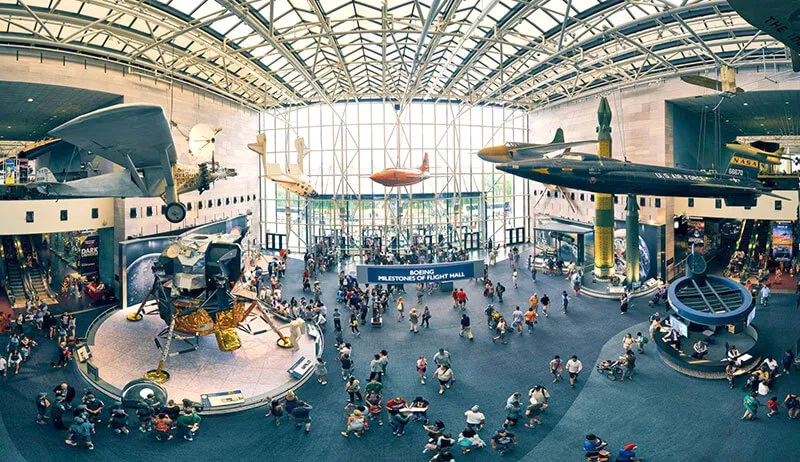
Ideal Angles and Times:
- Panoramic Angle of Exhibition Areas: Shoot panoramic views of the exhibition areas to show the diversity and richness of the museum. Use a wide-angle lens to encompass the vast space.
- Close-up Angle of Artifacts: Get closer and take close-up shots of historical artifacts such as airplanes, spaceships, rockets, and aviation equipment. Pay attention to technical details and unique designs.
- Angle from Above: If possible, find high vantage points to shoot down at the exhibition areas from above. This shooting angle will create an overview and impressive view of the museum.
- Photography in Low Light Conditions: Inside the museum is usually dimly lit. Be prepared to photograph in low light conditions or use flash if allowed.
- Portrait Photos with Artifacts: Take portrait photos of yourself or friends and family with air and space artifacts as a backdrop. These will be unique and memorable souvenirs.
Artistic Photography Tips:
- Use a Wide Aperture: In the low light conditions of the museum, use a wide aperture (small f-number) to capture more light and blur the background.
- Increase ISO: If you don’t want to use flash, you can increase ISO to increase the light sensitivity of the camera sensor. However, pay attention to noise when increasing ISO too high.
- Use a Tripod: If you want to take long exposure photos in low light conditions, use a tripod to keep the camera stable and avoid shaking.
- Find Creative Shooting Angles: Find creative and unique shooting angles to showcase air and space artifacts in a new way. Experiment with low angles, high angles, tilted angles, and abstract shooting angles.
- Tell a Story: Each artifact in the museum carries a historical and scientific story. Try to tell these stories through your photos. Use visual language to convey messages and emotions.
8. National Museum of Natural History: Exploring a Diverse World Through the Lens
The National Museum of Natural History is a priceless treasure trove of knowledge about the natural world and history. On an artistic photography tour, this museum offers a great opportunity to explore the diversity of the world and capture unique artifacts through the lens of photography.

Ideal Angles and Times:
- Panoramic Angle of Exhibition Areas: Shoot panoramic views of the exhibition areas to show the diversity and richness of the museum. Use a wide-angle lens to encompass the vast space.
- Close-up Angle of Artifacts: Get closer and take close-up shots of unique artifacts such as dinosaur skeletons, rare animals, mineral specimens, and historical relics. Pay attention to unique details and textures.
- Angle from Above: If possible, find high vantage points to shoot down at the exhibition areas from above. This shooting angle will create an overview and impressive view of the museum.
- Photography in Low Light Conditions: Similar to the Air and Space Museum, the Museum of Natural History also has low light. Be prepared to photograph in low light conditions or use flash if allowed.
- Portrait Photos with Artifacts: Take portrait photos of yourself or friends and family with natural history artifacts as a backdrop. These will be unique and educational souvenirs.
Artistic Photography Tips:
- Use Natural Light: If possible, take advantage of natural light from windows or skylights in the museum. Natural light will help highlight the colors and textures of the artifacts.
- Focus on Details: Artifacts in the Museum of Natural History often have many interesting details. Focus on these details and take close-up shots to discover the hidden beauty within.
- Use Macro Technique: To take close-up shots of small details such as insects, mineral specimens, or details on dinosaur skeletons, use a macro lens. Macro lenses will help you magnify the subject and capture the smallest details.
- Find Contrast: Find contrast in color, shape, and texture between artifacts and the surrounding space. Contrast will help create impressive and eye-catching photos.
- Creative Photography: Be creative and experiment with different shooting angles, compositions, and techniques to create unique and personal photos. Don’t be afraid to break the mold and express your own style on an artistic photography tour.
Conclusion: Washington DC Artistic Photography Tour – A Journey to Discover Endless Beauty
Washington DC is not only the political capital of the United States but also a treasure trove of unique culture, history, and architecture. An artistic photography tour in Washington DC will give you the opportunity to explore this city in a completely new way, through the creative and artistic lens of photography.
From magnificent architectural works such as the White House, Capitol Building, Lincoln Memorial, and Jefferson Memorial to green spaces like the Tidal Basin and world-famous museums, every location in Washington DC is an endless source of inspiration for photographers.
Prepare your camera, plan your artistic photography tour, and explore Washington DC in your own way. You are sure to bring back impressive works of art and unforgettable memories from this journey.